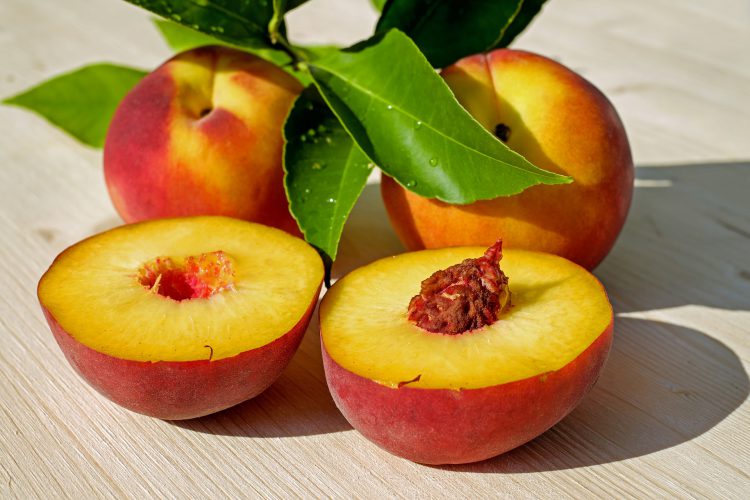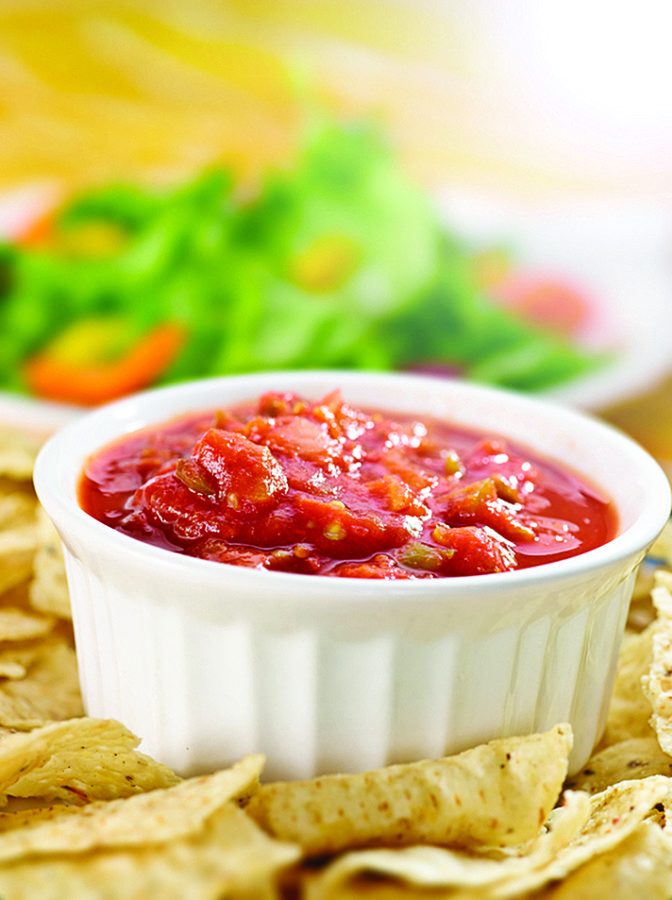Peach Salsa
 Ingredients
Ingredients
- 2 ¼ cups fresh peaches, peeled and chopped (about 2 large peaches)
- 1 tablespoon finely chopped red pepper or jalapeno (if you like a little heat)
- 1 tablespoon sugar
- 1 tablespoon finely chopped fresh cilantro
- 2 teaspoons fresh lemon juice
Directions
Combine all ingredients in a bowl. Serve over chicken or fish.
Adapted from Cooking Light
Healthy Eating on a Busy Schedule
Life can get pretty hectic with family, work, school, and other responsibilities. This makes it challenging to prioritize our health. To make it easier to have a healthy diet in the midst of a busy schedule, try these ideas and tips:
- Meal Planning: Schedule time each week to plan what meals you’ll eat that week and your grocery list. Consider the rainbow of fruits and vegetables every week as you plan. This will help ensure you’re getting a variety of nutrients, as each color offers different nutrients your body needs. Also, use weekly grocery store ads and plan meals around
 what’s on sale. Have a list of your family’s go-to meals that you enjoy. Start with some of those meals each week and plan your other meals around those meals. You can try theme meals such as Meatless Monday, Taco Tuesday, Fish Friday, and others that can help you think of a variety of nutritious meals to cook that week. Use a meal planning template like this one to make meal planning easier.
what’s on sale. Have a list of your family’s go-to meals that you enjoy. Start with some of those meals each week and plan your other meals around those meals. You can try theme meals such as Meatless Monday, Taco Tuesday, Fish Friday, and others that can help you think of a variety of nutritious meals to cook that week. Use a meal planning template like this one to make meal planning easier. - Organization & Keeping Stock: Shuffling through your refrigerator and pantry takes time. Keep your food storage organized so you know exactly what food you have on hand, saving valuable time. You can pick up pantry staples when they are on sale to build up your stock and be prepared to cook a meal on short notice. Here are some foods to keep on hand:
- Pantry: oats, brown rice, canned beans, whole wheat pasta, lentils, canned tomato sauce, canned vegetables, canned fruit, canned tuna or salmon, canned chicken, low-sodium soup, nuts and seeds, dried fruit, white vinegar, olive oil, vegetable oil, ground black pepper, garlic powder, cumin, paprika, salt, cinnamon, chili powder, ground ginger, basil, oregano, onion powder, non-stick cooking spray, whole wheat flour, all-purpose flour
- Refrigerator: fruits, vegetables, milk, eggs, cheese, salad greens, yogurt, low-fat mayonnaise, low-sodium soy sauce
- Freezer: chicken, lean ground beef, whole wheat bread, frozen fruit, frozen vegetables
- Prep in Advance: When possible, prepare meals and snacks in advance. For example, snacks like trail mix and hard-boiled eggs can be made in advance and enjoyed throughout the week. When you cook foods like dried beans and brown rice that take longer to cook, cook double and refrigerate or freeze the leftovers. Cut up vegetables like carrots, celery, and cucumber that can be eaten raw and store in containers in the fridge for an easy snack.
- Use Leftovers: Keep leftovers in the front of the fridge where you’ll remember to use them. Rather than throwing out those leftovers that you don’t know what to do with, combine them with another food to make a meal. Doing this saves money because you’re not throwing away the food you bought. For example, use leftover mixed vegetables in an omelet.
- Slow Cooker: Take advantage of a slow cooker, which can do all the cooking of a meal for you. Set up your meal in the morning before work and dinner will be ready for you when you get home at the end of the day. You can also use a slow cooker to cook individual parts of a meal, such as shredded chicken or dry beans. If you use your slow cooker to make red kidney beans, make sure you boil them on the stovetop before finishing cooking in a slow cooker.
When your life gets busy, don’t let healthy eating be another source of stress. Keep it simple with useful tips like these to make healthy eating for your family as easy as possible.
-Cara
Fresh-Made Salsa

Makes 2 cups
Ingredients
- ½ medium yellow onion, finely chopped
- 1 green bell pepper, finely chopped
- 2 tablespoons cilantro, chopped
- 1 tablespoon lime juice, or juice from half a lime
- 1 (14.5-ounce) can diced tomatoes, drained, liquid reserved or 1 ½ cups chopped fresh tomatoes
- ½ teaspoon cumin
Directions
- Rinse and cut onion, pepper, cilantro, and lime.
- Combine all ingredients in a bowl.
- Add some reserved tomato liquid to thin salsa if desired.
- Cover and refrigerate 30 minutes to 24 hours to allow flavors to blend.
Source: Cooking with EFNEP
Preparing Your Preschooler for Kindergarten

Your child’s toddler and preschool years are the time to prepare them for kindergarten. While kindergarten may seem far off, there are many factors that go into kindergarten readiness, including gross and fine motor skills, that your child should be developing as they grow. Motor skills are related to your child’s physical abilities and muscular development, making them great skills to practice during play.
Examples of gross motor skills are running and jumping, while fine motor skills involve smaller finger movements like holding a pencil. Activities to help develop these skills include the following:
- Popping Bubbles: chasing after bubbles and trying to pop them helps with fine motor development.
- Monkey Bars: climbing on monkey bars helps children develop muscle strength.
- Kicking and Throwing a Ball: kicking a ball helps with balance and throwing a ball helps with coordination.
- Simon Says: leading your children in Simon Says, you can have them do movements that help with motor development, such as side bends, touch toes, and jumping jacks.
- Obstacle Course: set up an obstacle course with any materials available to you, such as a hula hoop for children to jump in and out of.
- Hopscotch: going back and forth between hopping on one foot and two feet can help with balance and coordination.
Motor development is just one aspect of kindergarten readiness. To learn more about preparing for kindergarten, visit http://www.pbs.org/parents/experts/archive/2011/08/helping-children-prepare-for-k.html and http://www.mayoclinic.org/healthy-lifestyle/childrens-health/in-depth/kindergarten-readiness/art-20048432?pg=1
Tell us what activities you try with your children!
August is National Breastfeeding Month
 Breastmilk provides your baby with the best source of nutrition they can get. However, breastfeeding may not come easily for mom and baby–it takes practice! The key is to do the best you can and get the support you need from healthcare providers trained in breastfeeding support and friends and family. To recognize National Breastfeeding Month, we’re sharing just a few of the many benefits of breastfeeding:
Breastmilk provides your baby with the best source of nutrition they can get. However, breastfeeding may not come easily for mom and baby–it takes practice! The key is to do the best you can and get the support you need from healthcare providers trained in breastfeeding support and friends and family. To recognize National Breastfeeding Month, we’re sharing just a few of the many benefits of breastfeeding:
- For Mom: Moms who breastfeed have a lower risk of getting type 2 diabetes, certain types of breast cancer, and ovarian cancer. Breastfeeding can even help moms lose weight and tighten their bellies. Breastfeeding can also be more convenient than formula feeding. For one, you don’t have to worry about the temperature of the milk. There is no need to sterilize bottles or artificial nipples and you don’t have to buy, measure, or mix formula, which can save valuable time. Breastfeeding bonds mom and baby together, helping them form a special relationship.
- For Baby: Breastfed babies are less likely to get ear infections, diarrhea, and vomiting, and they have a lower risk of getting type 2 diabetes, asthma, and becoming obese during childhood. Breastmilk is easier for babies to digest than formula, making breastmilk easier on their bellies. In fact, mothers’ bodies naturally adjust the nutrition content of their breastmilk supplying all the baby needs. The closeness of breastfeeding makes babies feel safe and comforted.
- For Society: Breastfeeding saves babies’ lives. Research shows that if 90% of families exclusively breastfed for the first 6 months of a baby’s life, almost 1,000 infant deaths each year could be prevented. Breastfeeding saves the community money as it prevents illness, which reduces healthcare costs. Formula feeding creates waste for the environment (from formula cans and bottle supplies), so breastfeeding can help reduce waste.
Many women pump and store breast milk so they can return to work. Like any other food, it’s important to store pumped breastmilk properly to keep your baby safe. For tips on storing breastmilk properly, visit https://www.cdc.gov/breastfeeding/recommendations/handling_breastmilk.htm.
There are many opportunities for emotional support as well as help with breastfeeding for breastfeeding moms. Using these resources is key to breastfeeding success. Whether you’re a breastfeeding mom or have a friend or family member who is pregnant or has a baby, keep these options in mind:
- Lactation Consultant: International Board Certified Lactation Consultants (IBCLCs) are your go-to healthcare providers when it comes to breastfeeding. Lactation consultants are available at hospitals, community health programs like WIC, pediatrician offices, and other locations. Many can even do home visits! Talk to your doctor if you’d like to meet with a lactation consultant.
- WIC & Community Programs: The Special Supplemental Nutrition Program for Women, Infants, and Children (called “WIC”) offers breastfeeding counseling and may be able to provide breast pumps and other supplies. To find your local WIC program, visit https://www.fns.usda.gov/wic/breastfeeding-priority-wic-program.
- Family and Friends: Loved ones can encourage you to breastfeed through all the ups and downs of breastfeeding. They’re the ones there for you when healthcare providers can’t be there (at home in the middle of the night, for example). Family and friends can also offer other help, such as changing the baby, getting the baby ready to be fed, making sure you have enough water to drink and get enough rest, helping around the house, caring for other children at home, and loving and playing with the baby.
- Other Breastfeeding Moms: Other breastfeeding moms can offer advice, support, and encouragement. There are different ways to connect with other breastfeeding moms at breastfeeding support groups. You can talk to your doctor, who may know about a breastfeeding support group at their office or a nearby hospital. Also, you can check Internet websites like the Nursing Mothers Advisory Council and breastfeeeding.org to find a breastfeeding support group near you. Your local La Leche League may offer meetings near you where you can connect with other breastfeeding moms.
- The National Breastfeeding Helpline: You can call 1-800-994-9662 to talk to trained breastfeeding peer counselors who can answer women’s health and breastfeeding questions in English or Spanish. This is a free service and you can call as much as you need!
Breastfeeding is natural and the rewards and benefits of breastfeeding for you and your baby are endless. With the assistance of health care providers, family and loved ones, and other breastfeeding moms, you can get the support to help overcome challenges you may have.
-Cara